Evaluation of the IASI/Metop Dust Flag Product Using AERONET Data
Abstract
1. Introduction
2. Materials and Methods
2.1. IASI/MetOp
2.2. AERONET
2.3. Aerosol Classification Using AERONET
2.4. Methodology
3. Results
3.1. Dust Flag as an Indicator of Dust Presence
3.2. Dust Flag as an Indicator of Dust Load
3.3. Spatial Variability
4. Conclusions
Author Contributions
Funding
Institutional Review Board Statement
Informed Consent Statement
Data Availability Statement
Acknowledgments
Conflicts of Interest
Appendix A
| Station Name | Latitude (deg.) | Longitude (deg.) | Agreement Score |
|---|---|---|---|
| Banizoumbou | 13.58 | 2.6 | 100.0 |
| Camaguey | 21.28 | −77.82 | 100.0 |
| Capo_Verde | 16.58 | −23.03 | 100.0 |
| Georgia_Tech | 33.78 | −84.49 | 100.0 |
| IER_Cinzana | 13.45 | −5.88 | 100.0 |
| Jabiru | −12.69 | 132.78 | 100.0 |
| Koforidua_ANUC | 6.03 | −0.39 | 100.0 |
| Kupang | −10.1 | 123.63 | 100.0 |
| LAMTO-STATION | 6.09 | −4.98 | 100.0 |
| Ragged_Point | 13.3 | −59.52 | 100.0 |
| SEGC_Lope_Gabon | −0.34 | 11.68 | 100.0 |
| Zinder_Airport | 13.75 | 8.94 | 100.0 |
| Ilorin | 8.47 | 4.7 | 99.84 |
| Medenine-IRA | 33.5 | 10.62 | 99.67 |
| CATUC_Bamenda | 6.06 | 10.15 | 99.04 |
| Dakar_Belair | 14.75 | −17.53 | 98.88 |
| Karachi | 24.92 | 67.03 | 98.8 |
| Dushanbe | 38.56 | 69.05 | 98.17 |
| Cairo_EMA_2 | 30.01 | 31.34 | 97.03 |
| Mezaira | 23.14 | 53.76 | 95.99 |
| IMAA_Potenza | 40.64 | 15.73 | 93.58 |
| Cabo_da_Roca | 38.74 | −9.64 | 93.22 |
| KAUST_Campus | 22.27 | 39.03 | 92.61 |
| Paris | 48.82 | 2.11 | 92.59 |
| Univ_of_Houston | 29.61 | −95.2 | 92.31 |
| Masdar_Institute | 24.39 | 54.76 | 91.3 |
| Saada | 31.58 | −8.06 | 88.27 |
| Izana | 28.13 | −16.46 | 87.38 |
| Weizmann_Institute | 31.9 | 34.91 | 86.73 |
| Granada | 37.3 | −3.65 | 86.25 |
| Evora | 38.74 | −7.89 | 85.94 |
| SP_Bayboro | 27.72 | −82.7 | 85.71 |
| Modena | 44.79 | 10.86 | 85.19 |
| Eilat | 29.59 | 34.96 | 84.67 |
| Lamezia_Terme | 38.81 | 16.07 | 83.67 |
| Toulouse_MF | 43.58 | 1.53 | 83.65 |
| Thessaloniki | 40.56 | 23.12 | 83.54 |
| Aubiere_LAMP | 45.68 | 3.25 | 83.33 |
| Finokalia-FKL | 35.34 | 25.6 | 82.96 |
| SEDE_BOKER | 30.81 | 34.84 | 82.2 |
| Barcelona | 41.34 | 2.24 | 82.08 |
| Murcia | 38.17 | −1.17 | 81.8 |
| Issyk-Kul | 42.65 | 76.77 | 81.4 |
| Ascension_Island | −7.91 | −14.33 | 81.25 |
| Toulon | 43.19 | 6.08 | 81.19 |
| Zaragoza | 41.62 | −0.7 | 80.69 |
| Palencia | 42.1 | −4.43 | 80.0 |
| Migal | 33.19 | 35.57 | 79.5 |
| IMS-METU-ERDEMLI | 36.48 | 34.15 | 77.21 |
| Chiba_University | 35.67 | 140.16 | 75.61 |
| Aspendale_Mel_AU | −38.09 | 144.9 | 75.0 |
| Tamanrasset_INM | 22.86 | 5.68 | 74.55 |
| University_of_Nizwa | 22.88 | 57.51 | 74.54 |
| Lecce_University | 40.39 | 18.29 | 74.33 |
| Valladolid | 41.6 | −4.84 | 73.81 |
| DEWA_ResearchCentre | 24.91 | 55.37 | 73.39 |
| ICIPE-Mbita | −0.31 | 34.33 | 73.33 |
| Antikythera_NOA | 35.78 | 23.2 | 72.6 |
| ATHENS_NTUA | 38.04 | 23.65 | 72.41 |
| IASBS | 36.79 | 48.58 | 72.41 |
| Hokkaido_University | 43.02 | 141.3 | 72.0 |
| Rome_La_Sapienza | 41.95 | 12.64 | 71.75 |
| Madrid | 40.44 | −3.82 | 70.23 |
| Gandhi_College | 26.01 | 84.14 | 69.67 |
| Seoul_SNU | 37.47 | 126.97 | 64.79 |
| Osaka | 34.72 | 135.69 | 63.89 |
| Birdsville | −25.8 | 139.22 | 56.47 |
| Fowlers_Gap | −31.24 | 141.59 | 55.56 |
| Dalanzadgad | 43.53 | 104.61 | 51.42 |
| Dhaka_University | 23.67 | 90.22 | 50.32 |
| NEON_CLBJ | 33.27 | −97.69 | 48.0 |
| Nicosia | 35.13 | 33.57 | 43.94 |
| AAU_Jackros_ET | 8.94 | 38.93 | 33.33 |
| Learmonth | −22.15 | 114.04 | 33.33 |
| YUMA_SL | 32.73 | −114.58 | 30.98 |
| Karunya_University | 10.88 | 76.7 | 25.0 |
| UEM_Maputo | −25.93 | 32.79 | 25.0 |
| Dongsha_Island | 20.81 | 116.81 | 12.3 |
| Sevilleta | 34.35 | −107.02 | 12.26 |
| Upington | −28.47 | 21.01 | 12.0 |
| Gobabeb | −23.64 | 15.09 | 10.06 |
| Tucson | 32.18 | −110.84 | 9.76 |
| Skukuza | −24.93 | 31.74 | 9.09 |
| NEON_ONAQ | 40.15 | −112.28 | 7.34 |
| Mexico_City | 19.48 | −99.19 | 6.67 |
| MISR-JPL | 34.11 | −118.3 | 6.25 |
| Windpoort | −19.3 | 15.55 | 5.06 |
| HESS | −23.15 | 16.52 | 4.72 |
| NEON_MOAB | 38.33 | −109.39 | 3.12 |
| Univ_of_Nevada-Reno | 39.61 | −119.74 | 1.32 |
| Bujumbura | −3.49 | 29.35 | 0.0 |
| CCNY | 40.88 | −73.96 | 0.0 |
| CEILAP-Comodoro | −45.68 | −67.62 | 0.0 |
| CEILAP-Neuquen | −39.04 | −68.25 | 0.0 |
| CUIABA-MIRANDA | −15.75 | −56.13 | 0.0 |
| GasLab_SJ_CostaRica | 9.92 | −83.9 | 0.0 |
| Howard_Univ-IRB | 38.91 | −77.23 | 0.0 |
| Los_Alamos | 35.74 | −106.25 | 0.0 |
| Luang_Namtha | 21.0 | 101.29 | 0.0 |
| Lubango | −15.04 | 13.35 | 0.0 |
| Lulin | 23.46 | 120.8 | 0.0 |
| Maido_OPAR | −20.99 | 55.41 | 0.0 |
| Manila_Observatory | 14.64 | 121.03 | 0.0 |
| Maun_Tower | −19.93 | 23.41 | 0.0 |
| Metsi | −26.58 | 27.29 | 0.0 |
| Misamfu | −10.27 | 31.3 | 0.0 |
| Mongu_Inn | −15.23 | 22.98 | 0.0 |
| NEON_LENO | 31.82 | −88.32 | 0.0 |
| NEON_MLBS | 37.46 | −80.36 | 0.0 |
| NGHIA_DO | 21.04 | 105.92 | 0.0 |
| Niassa | −12.22 | 37.46 | 0.0 |
| Petrolina_SONDA | −8.94 | −40.24 | 0.0 |
| Pretoria_CSIR-EC | −25.87 | 28.29 | 0.0 |
| Quito_USFQ | −0.17 | −78.44 | 0.0 |
| REUNION_ST_DENIS | −20.78 | 55.61 | 0.0 |
| Sakeji_School | −11.28 | 24.31 | 0.0 |
| Singapore | 1.18 | 103.69 | 0.0 |
| Sra_Kaeo | 13.67 | 102.62 | 0.0 |
| St_Helena | −15.86 | −5.62 | 0.0 |
| Univ_of_Auckland | −36.85 | 174.78 | 0.0 |
Appendix B
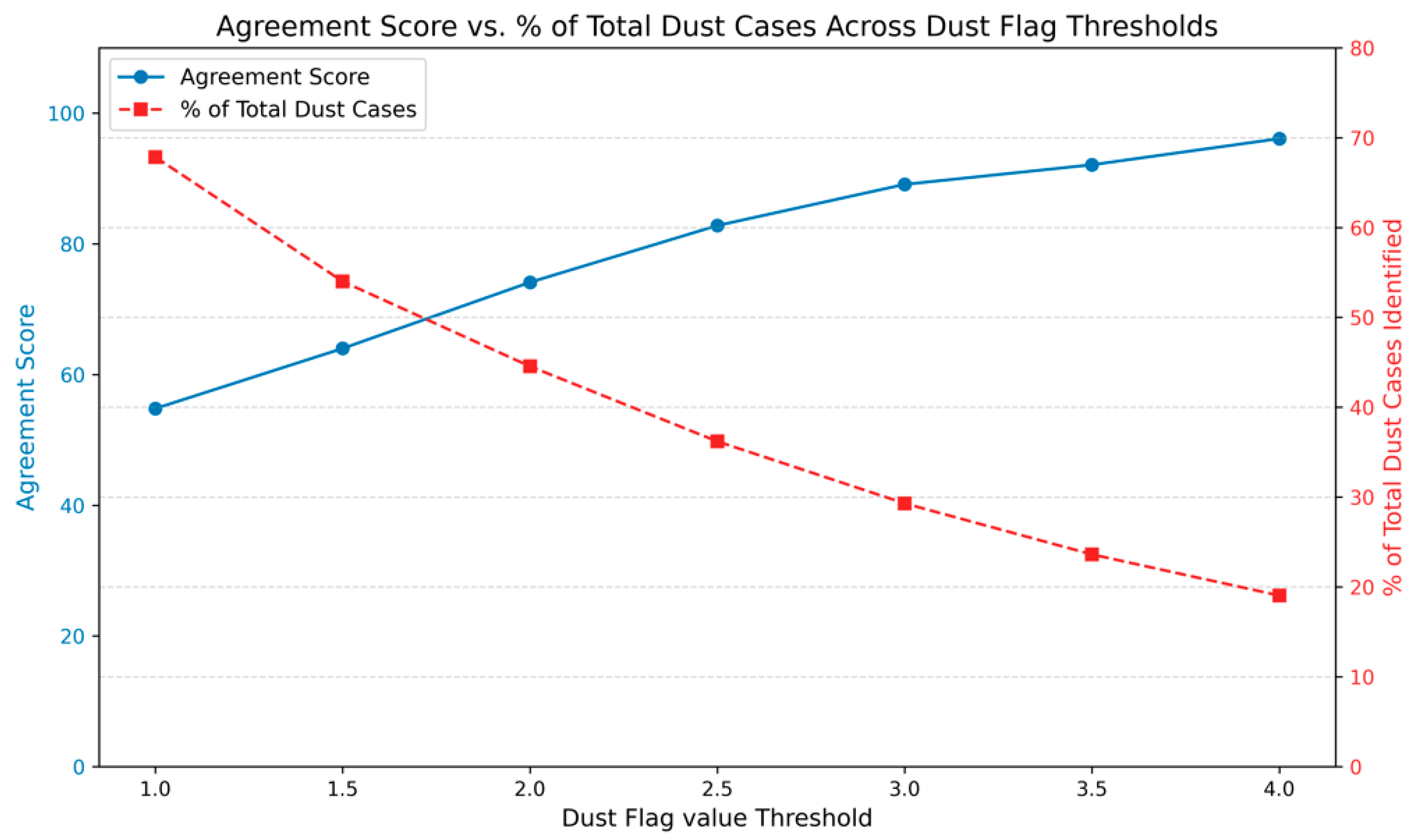
References
- Zender, C.; Bian, H.; Newman, D. Mineral Dust Entrainment And Deposition (DEAD) model: Description and 1990s dust cli-matology. J. Geophys. Res 2003, 108, 4416–4435. [Google Scholar] [CrossRef]
- von Holdt, J.; Eckardt, F.; Baddock, M.; Wiggs, G. Assessing Landscape Dust Emission Potential Using Combined Ground-Based Measurements and Remote Sensing Data. J. Geophys. Res. 2019, 124, 1080–1098. [Google Scholar] [CrossRef]
- Kok, J.; Adebiyi, A.; Albani, S.; Balkanski, Y.; Checa-Garcia, R.; Chin, M.; Colarco, P.; Hamilton, D.; Huang, Y.; Ito, A.; et al. Contribution of the world’s main dust source regions to the global cycle of desert dust. Atmos. Chem. Phys. 2021, 21, 8169–8193. [Google Scholar] [CrossRef]
- Seinfeld, J.H.; Pandis, S.N.; Noone, K. Atmospheric Chemistry and Physics: From Air Pollution to Climate Change. Phys. Today 1998, 51, 88. [Google Scholar] [CrossRef]
- Middleton, N.; Goudie, A. Saharan dust: Sources and trajectories. Trans. Inst. Br. 2002, 26, 165–181. [Google Scholar] [CrossRef]
- Choobari, O.A.; Zawar-Reza, P.; Sturman, A. The global distribution of mineral dust and its impacts on the climate system: A review. Atmos. Res. 2014, 138, 152–165. [Google Scholar] [CrossRef]
- Alsharif, W.; Saad, M.; Hirt, H. Desert Microbes for Boosting Sustainable Agriculture in Extreme Environments. Front. Microbiol. 2020, 11. [Google Scholar] [CrossRef]
- Ginoux, P.; Chin, M.; Tegen, I.; Prospero, J.; Holben, B.; Dubovik, O.; Lin, S.J. Sources and distributions of dust aerosols simulated with the GOCART model. J. Geophys. Res. 2001, 106, 20255–20274. [Google Scholar] [CrossRef]
- Ginoux, P.; Prospero, J.; Gill, T.; Hsu, N.; Zhao, M. Global-scale attribution of anthropogenic and natural dust sources and their emission rates based on MODIS Deep Blue aerosol products. Rev. Geophys. 2012, 50, 3005. [Google Scholar] [CrossRef]
- Chen, S.; Chen, J.; Zhang, Y.; Lin, J.; Bi, H.; Song, H.; Chen, Y.; Lulu, L.; Liu, C.; Zhang, R. Anthropogenic dust: Sources, characteristics and emissions. Environ. Res. Lett. 2023, 18, 103002. [Google Scholar] [CrossRef]
- Tegen, I.; Fung, I. Contribution to the atmospheric mineral aerosol load from land surface modification. J. Geophys. Res. 1995, 100, 18707–18726. [Google Scholar] [CrossRef]
- Csavina, J.; Field, J.; Taylor, M.; Gao, S.; Landázuri, A.; Betterton, E.; Sáez, A. A Review on the Importance of Metals and Metalloids in Atmospheric Dust and Aerosol from Mining Operations. Sci. Total Environ. 2012, 433, 58–73. [Google Scholar] [CrossRef] [PubMed]
- Kok, J.; Ward, D.; Mahowald, N.; Evan, A. Global and regional importance of the direct dust-climate feedback. Nat. Commun. 2018, 9. [Google Scholar] [CrossRef] [PubMed]
- Kok, J.; Storelvmo, T.; Karydis, V.; Adebiyi, A.; Mahowald, N.; Evan, A.; He, C.; Leung, D. Mineral dust aerosol impacts on global climate and climate change. Nat. Rev. Earth Environ. 2023, 4, 71–86. [Google Scholar] [CrossRef]
- Shao, Y.; Klose, M.; Wyrwoll, K.H. Recent global dust trend and connections to climate forcing: Global dust trend. J. Geophys. Res. 2013, 118, 11107–11118. [Google Scholar] [CrossRef]
- Koehler, K.; DeMott, P.; Petters, M.; Prenni, A.; Carrico, C. Hygroscopicity and cloud droplet activation of mineral dust aerosol. Geophys. Res. Lett. 2009, 36, 8805–8810. [Google Scholar] [CrossRef]
- Intergovernmental Panel on Climate Change (IPCC). The Earth’s Energy Budget, Climate Feedbacks and Climate Sensitivity. In Climate Change 2021—The Physical Science Basis: Working Group I Contribution to the Sixth Assessment Report of the Intergovernmental Panel on Climate Change; Cambridge University Press: Cambridge, UK, 2023; pp. 923–1054. [Google Scholar] [CrossRef]
- Iacono, M.; Delamere, J.; Mlawer, E.; Shephard, M.; Clough, S.; Collins, W. Radiative Forcing by Long-Lived Greenhouse Gases: Calculations with the AER Radiative Transfer Models. J. Geophys. Res. 2008, 113, D13103. [Google Scholar] [CrossRef]
- Etminan, M.; Myhre, G.; Highwood, E.; Shine, K. Radiative forcing of carbon dioxide, methane, and nitrous oxide: A significant revision of the methane radiative forcing: Greenhouse gas radiative forcing. Geophys. Res. Lett. 2016, 43, 12614–12623. [Google Scholar] [CrossRef]
- Holben, B.; Nakajima, T.; Lavenu, I.; Jankowiak, I.; Smirnov, A.; Eck, T.; Slutsker, I.; Tanre, D.; Buis, J.P.; Setzer, A.; et al. AERONET-A Federated Instrument Network and Data Archive for aerosol characterization. Remote Sens. Environ. 1998, 66, 1–16. [Google Scholar] [CrossRef]
- Holben, B.; Tanre, D.; Smirnov, A.; Eck, T.; Slutsker, I.; Abuhassan, N.; Newcomb, W.W.; Schafer, J.; Chatenet, B.; Lavenue, F.; et al. An emerging ground-based aerosol climatology: Aerosol Optical Depth from AERONET. J. Geophys. Res. 2001, 106, 12067–12097. [Google Scholar] [CrossRef]
- Siomos, N.; Balis, D.; Voudouri, K.A.; Giannakaki, E.; Filioglou, M.; Amiridis, V.; Papayannis, A.; Fragkos, K. Are EARLINET and AERONET climatologies consistent? The case of Thessaloniki, Greece. Atmos. Chem. Phys. 2018, 18, 11885–11903. [Google Scholar] [CrossRef]
- Garane, K.; Chan, K.L.; Koukouli, M.; Loyola, D.; Balis, D. TROPOMI/S5P Total Column Water Vapor validation against AERONET ground-based measurements. Atmos. Meas. Tech. 2023, 16, 57–74. [Google Scholar] [CrossRef]
- Michailidis, K.; Garane, K.; Karagkiozidis, D.; Georgia, P.; Voudouri, K.; Balis, D.; Bais, A. Extreme wildfires over northern Greece during summer 2023—Part A: Effects on aerosol optical properties and solar UV radiation. Atmos. Res. 2024, 311, 107700. [Google Scholar] [CrossRef]
- Clerbaux, C.; Boynard, A.; Clarisse, L.; George, M.; Hadji-Lazaro, J.; Herbin, H.; Hurtmans, D.; Pommier, M.; Razavi, A.; Turquety, S.; et al. Monitoring of atmospheric composition using the thermal infrared IASI/MetOp sounder. Atmos. Chem. Phys. 2009, 9, 6041–6054. [Google Scholar] [CrossRef]
- Clarisse, L.; Clerbaux, C.; Franco, B.; Hadji-Lazaro, J.; Whitburn, S.; Kopp, A.; Hurtmans, D.; Coheur, P.F. A decadal data set of global atmospheric dust retrieved from IASI satellite measurements. J. Geophys. Res. 2019, 124, 1618–1647. [Google Scholar] [CrossRef]
- Clerbaux, C.; Hadji-Lazaro, J.; Turquety, S.; George, M.; Boynard, A.; Pommier, M.; Safieddine, S.; Coheur, P.F.; Hurtmans, D.; Clarisse, L.; et al. Tracking pollutants from space: Eight years of IASI satellite observation. C. R.-Geosci. 2015, 347, 134–144. [Google Scholar] [CrossRef]
- Blumstein, D.; Chalon, G.; Carlier, T.; Buil, C.; Hébert, P.; Maciaszek, T.; Ponce, G.; Phulpin, T.; Tournier, B.; Simeoni, D.; et al. IASI instrument: Technical overview and measured performances. Proc. SPIE-Int. Soc. Opt. Eng. 2004, 5543, 196–207. [Google Scholar] [CrossRef]
- Hilton, F.; Armante, R.; August, T.; Barnet, C.; Bouchard, A.; Camy-Peyret, C.; Capelle, V.; Clarisse, L.; Clerbaux, C.; Coheur, P.F.; et al. Hyperspectral Earth Observation from IASI: Five Years of Accomplishments. Bull. Am. Meteorol. Soc. 2012, 93, 347–370. [Google Scholar] [CrossRef]
- EUMETSAT, IASI Level 2: Product Guide, EUM/OPS-EPS/MAN/04/0033. Available online: https://user.eumetsat.int/s3/eup-strapi-media/IASI_Level_2_Product_Guide_8f61a2369f.pdf (accessed on 24 October 2025).
- Ackerman, S. Using the radiative temperature difference at 3.7 and 11-μm to track dust outbreaks. Remote Sens. Environ. 1989, 27, 129–133. [Google Scholar] [CrossRef]
- Clarisse, L.; Coheur, P.F.; Prata, F.; Hadji-Lazaro, J.; Hurtmans, D.; Clerbaux, C. A unified approach to infrared aerosol remote sensing and type specification. Atmos. Chem. Phys. 2013, 13, 2195–2221. [Google Scholar] [CrossRef]
- EUMETSAT, IASI Level 2: Product Generation Specification, EPS.SYS.SPE.990013. Available online: https://user.eumetsat.int/s3/eup-strapi-media/IASI_Level_2_Product_Generation_Specification_4676b85e0f.pdf (accessed on 24 October 2025).
- Washington, R.; Todd, M.; Engelstaedter, S.; Mbainayel, S.; Mitchell, F. Dust and the low-level circulation over the Bodélé Depression, Chad: Observations from BoDEx 2005. J. Geophys. Res. 2006, 111, 3201–3216. [Google Scholar] [CrossRef]
- De Rosa, B.; Mytilinaios, M.; Amodeo, A.; Colangelo, C.; D’Amico, G.; Dema, C.; Gandolfi, I.; Giunta, A.; Gumà-Claramunt, P.; Laurita, T.; et al. Observations of Saharan Dust Intrusions over Potenza, Southern Italy, During 13 Years of Lidar Measurements: Seasonal Variability of Optical Properties and Radiative Impact. Remote Sens. 2025, 17, 453. [Google Scholar] [CrossRef]
- Pacheco, S.; Guidos-Fogelbach, G.; Pawankar, R.; D’Amato, G.; Latour-Staffeld, P.; Urrutia-Pereira, M.; Kesic, M.; Hernandez, M. Climate Change and Global Issues in Allergy and Immunology. J. Allergy Clin. Immunol. 2021, 148, 1366–1377. [Google Scholar] [CrossRef]
- Mayol-Bracero, O.; Prospero, J.; Sarangi, B.; Andrews, E.; Colarco, P.; Cuevas, E.; Girolamo, L.; Garcia, R.; Gaston, C.; Holben, B.; et al. “Godzilla”, the extreme African dust event of June 2020: Origins, Transport, and Impact on Air Quality in the Greater Caribbean Basin. Bull. Am. Meteorol. Soc. 2025, 106, E1620–E1648. [Google Scholar] [CrossRef]
- Chang, C.H.; Hosseinpour, F. Relationships between Aerosols and Marine Clouds during the “Godzilla” Dust Storm: Perspective of Satellite and Reanalysis Products. Atmosphere 2023, 15, 13. [Google Scholar] [CrossRef]
- Jackson, J.; Liu, H.; Laszlo, I.; Kondragunta, S.; Remer, L.; Huang, J.; Huang, H.-C. Suomi-NPP VIIRS aerosol algorithms and data products. J. Geophys. Res. 2013, 118, 12673–12689. [Google Scholar] [CrossRef]
- Whitburn, S.; Clarisse, L.; Crapeau, M.; August, T.; Hultberg, T.; Coheur, P.F.; Clerbaux, C. A CO2-independent cloud mask from Infrared Atmospheric Sounding Interferometer (IASI) radiances for climate applications. Atmos. Meas. Tech. 2022, 15, 6653–6668. [Google Scholar] [CrossRef]
- CIMEL: Multiband Photometer CE318-N User’s Operation Manual, Firmware Version 5.0 and Above, 2018. Available online: https://aeronet.gsfc.nasa.gov/new_web/Documents/CE318_N_Photometer_UserManual_V5.pdf (accessed on 24 October 2025).
- Torres, O.; Bhartia, P.; Herman, J.; Sinyuk, A.; Ginoux, P.; Holben, B. A Long-Term Record of Aerosol Optical Depth from TOMS Observations and Comparison to AERONET Measurements. J. Atmos. Sci. 2002, 59, 398–413. [Google Scholar] [CrossRef]
- Smirnov, A.; Holben, B.; Eck, T.; Slutsker, I.; Chatenet, B.; Pinker, R. Diurnal variability of aerosol optical depth observed at AERONET (Aerosol Robotic Network) sites. Geophys. Res. Lett. 2002, 29, 30-1–30-4. [Google Scholar] [CrossRef]
- Eck, T.; Holben, B.; Reid, J.; Dubovik, O.; Smirnov, A.; Smirnov, N.; Slutsker, I.; Kinne, S. Wavelength dependence of the optical depth of biomass burning, urban, and desert dust aerosols. J. Geophys. Res. 1999, 104349, 31333–31349. [Google Scholar] [CrossRef]
- Dubovik, O.; Holben, B.; Eck, T.; Smirnov, A.; Kaufman, Y.; King, M.; Tanré, D.; Slutsker, I. Variability of Absorption and Optical Properties of Key Aerosol Types Observed in Worldwide Locations. J. Atmos. Sci. 2002, 59, 590–608. [Google Scholar] [CrossRef]
- Raptis, P.; Kazadzis, S.; Amiridis, V.; Gkikas, A.; Gerasopoulos, E.; Mihalopoulos, N. A Decade of Aerosol Optical Properties Measurements over Athens, Greece. Atmosphere 2020, 11, 154. [Google Scholar] [CrossRef]
- Zachary, M.; Niu, S.; Lü, J. Aerosol Optical and Micro-Physical Characteristic Derived from AERONET in Kenya*. Open Access Lib. J. 2018, 5, 1–16. [Google Scholar] [CrossRef]
- Basheer, K.; Rajab, J.; Al-Salihi, A. Climatology and classification of aerosols based on optical properties over selected stations in Iraq. AIP Conf. Proc. 2020, 2290, 050041. [Google Scholar] [CrossRef]
- Ashrafi, K.; Shafiepour-Motlagh, M.; Aslemand, A.; Ghader, S. Dust storm simulation over Iran using HYSPLIT. Iran. J. Environ. Health Sci. Eng. 2014, 12, 9. [Google Scholar] [CrossRef]
- Varga, G. Spatio-temporal distribution of dust storms—A global coverage using NASA TOMS aerosol measurements, Foldrajzi Ertesito. Hung. Geogr. Bull. 2012, 61, 275–298. [Google Scholar]
- Schepanski, K. Transport of Mineral Dust and Its Impact on Climate. Geosci. J. 2018, 8, 151. [Google Scholar] [CrossRef]
- Tindan, J.; Jin, Q.; Pu, B. Understanding day-night differences in dust activities over the dust belt of North Africa, the Middle East, and Asia. Atmos. Chem. Phys. 2022, 23, 5435–5466. [Google Scholar] [CrossRef]
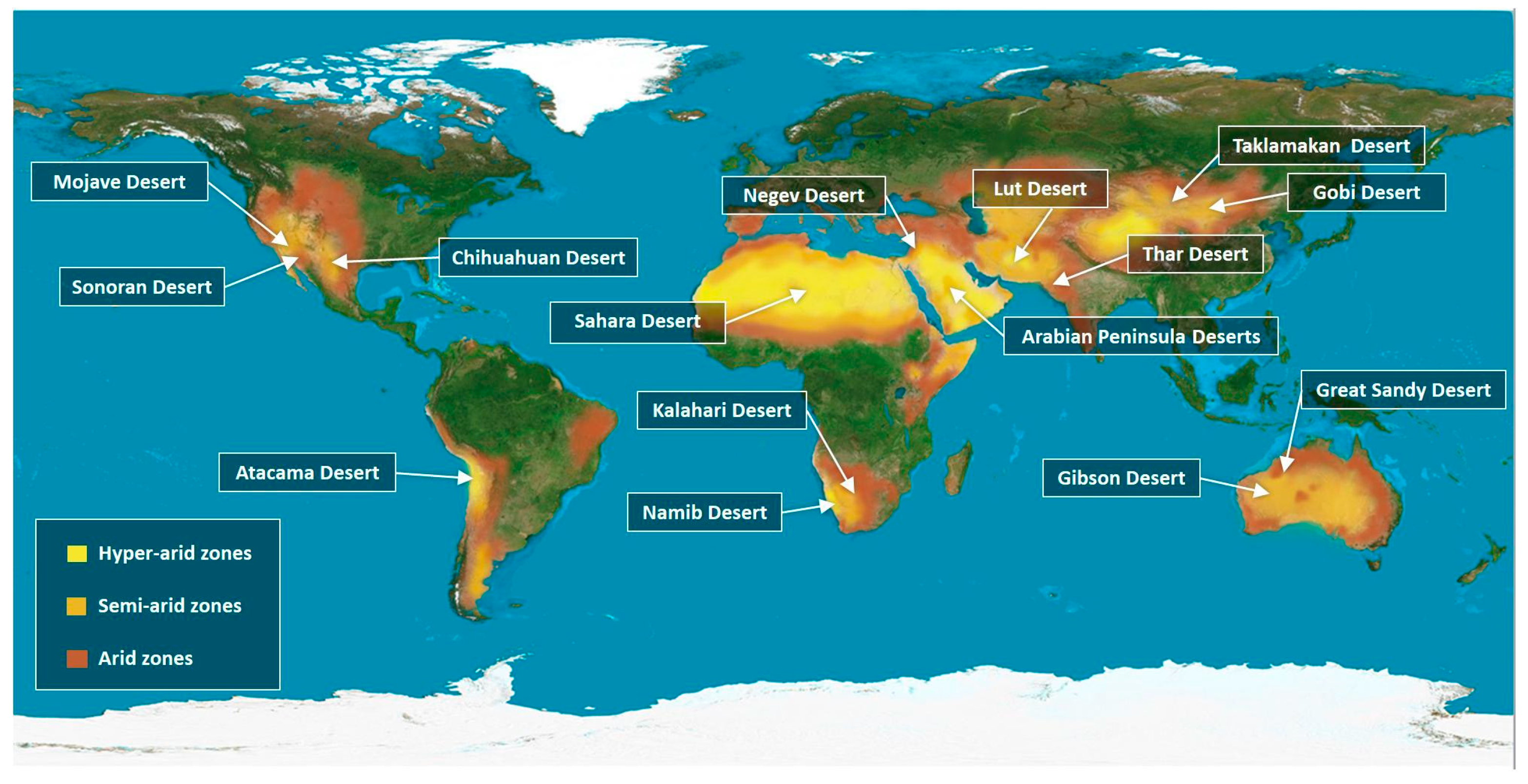

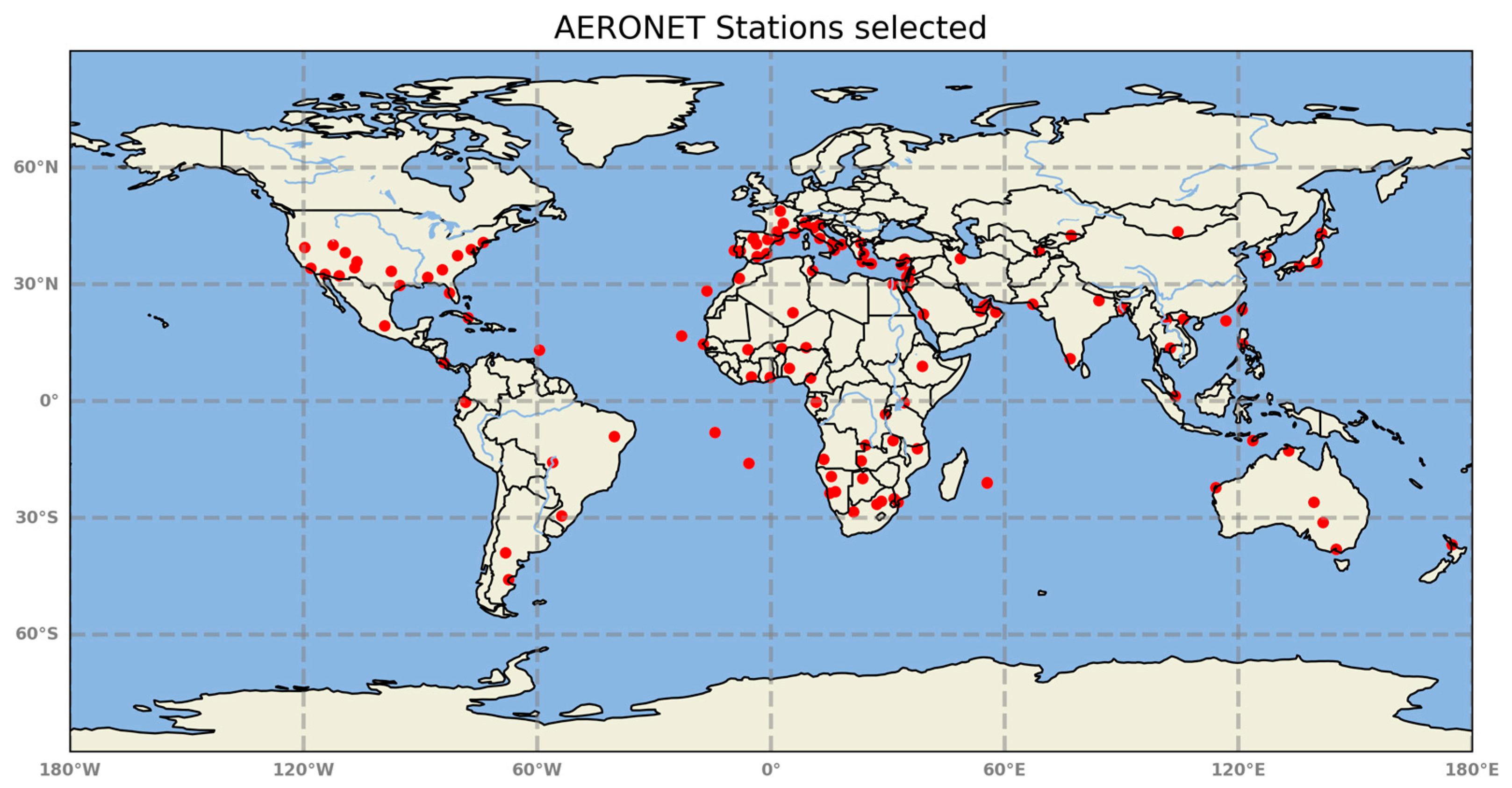
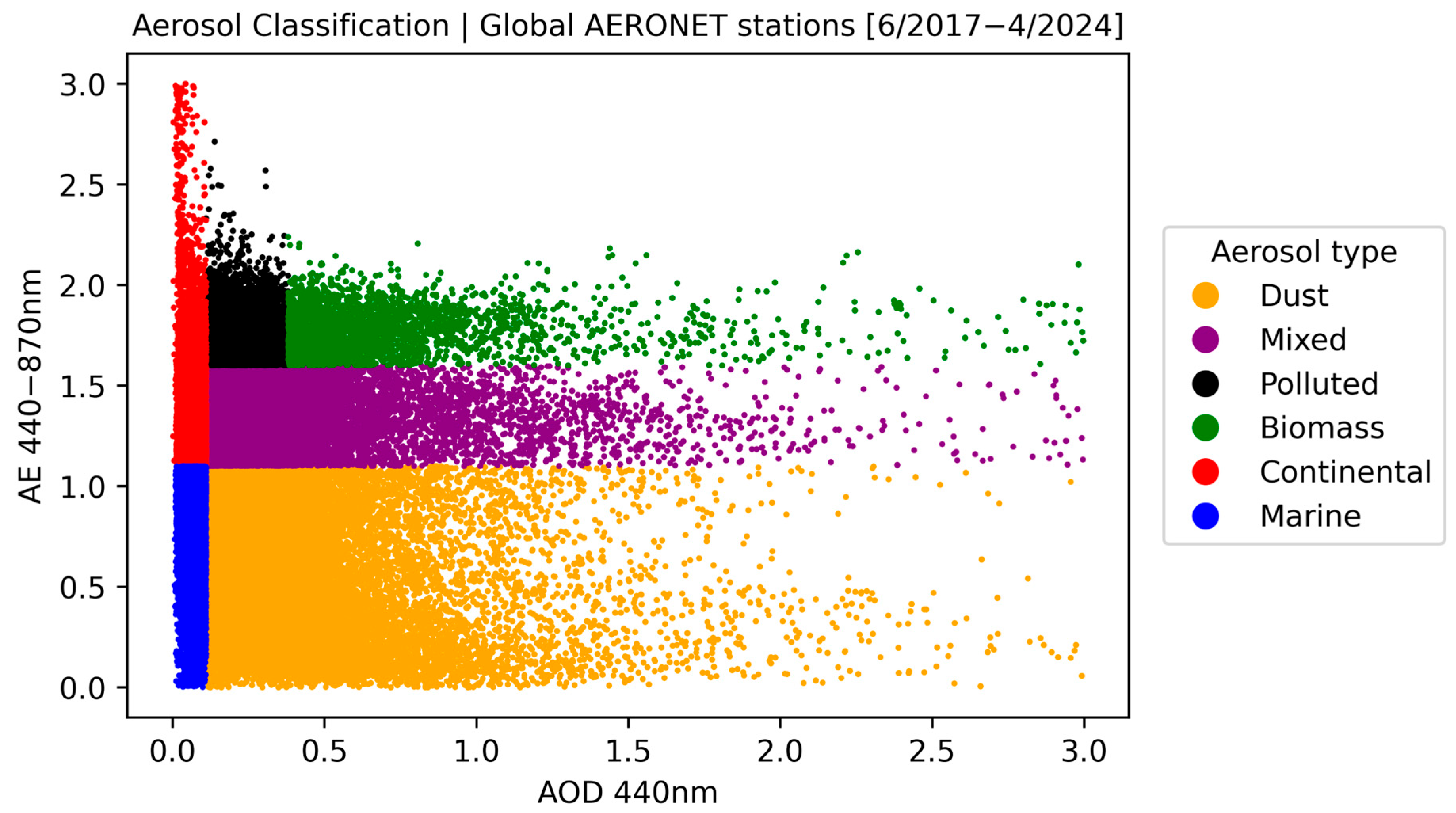
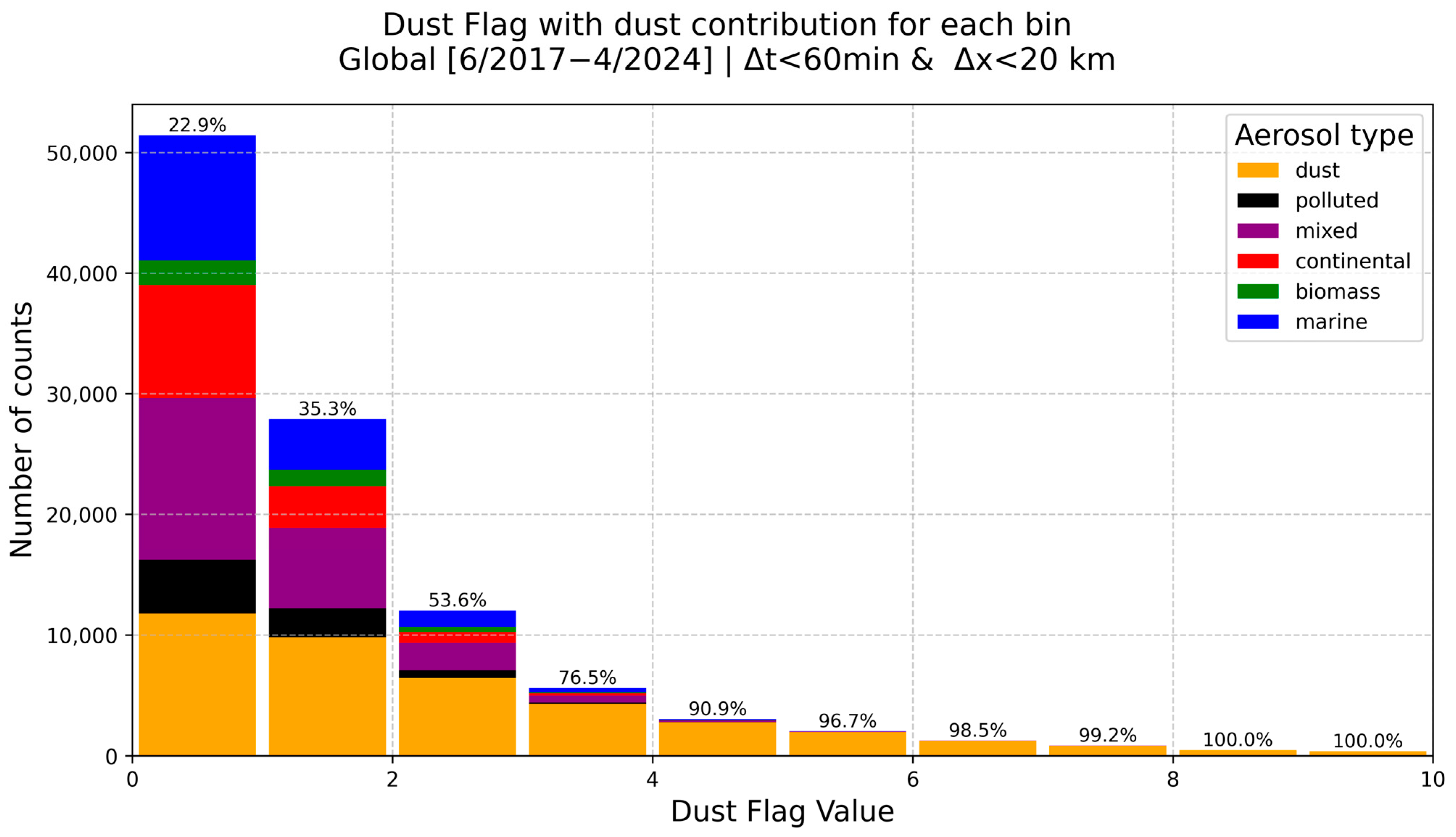
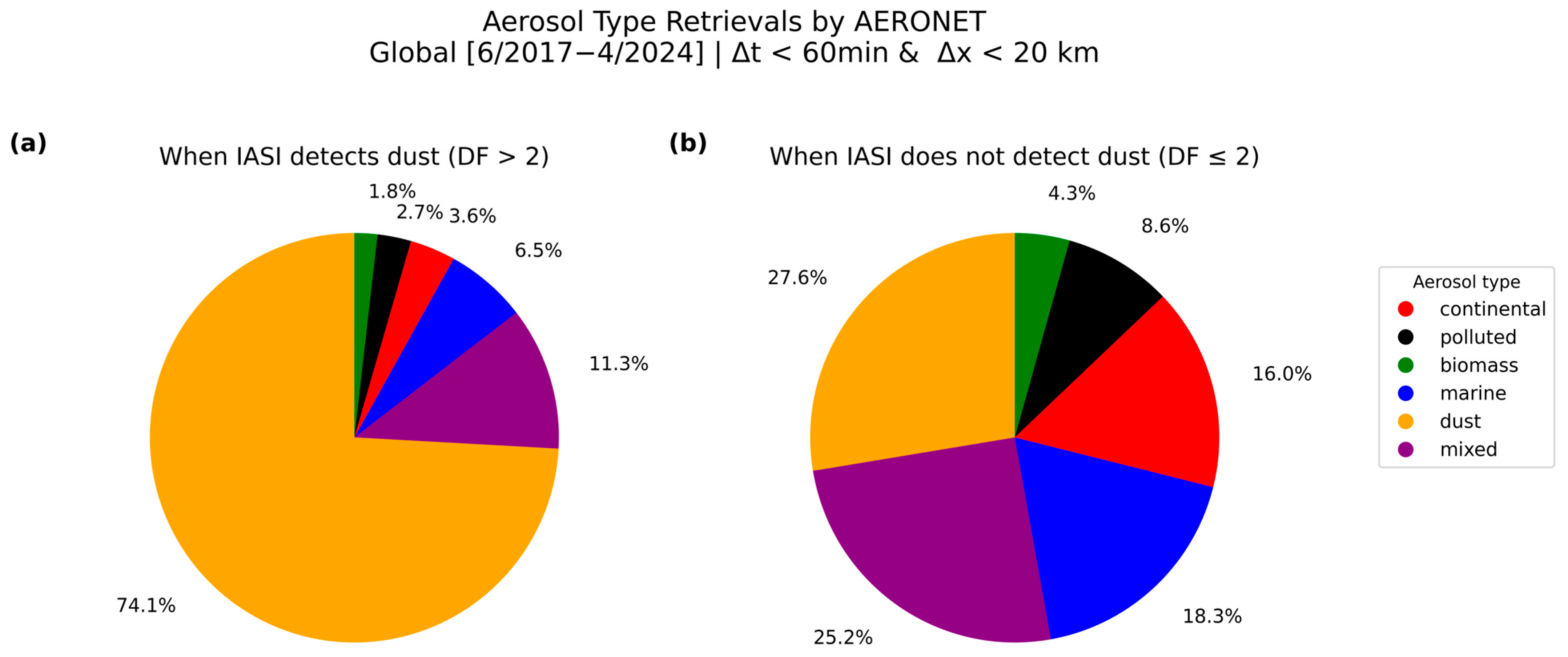
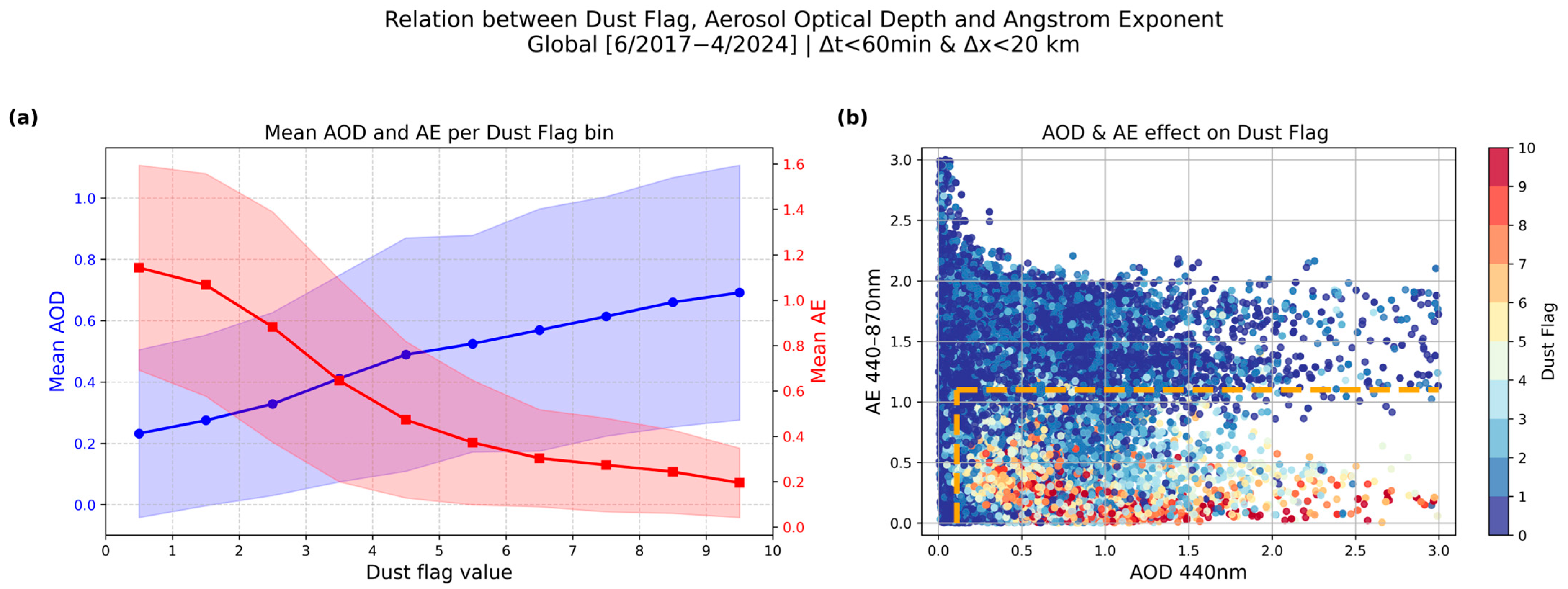

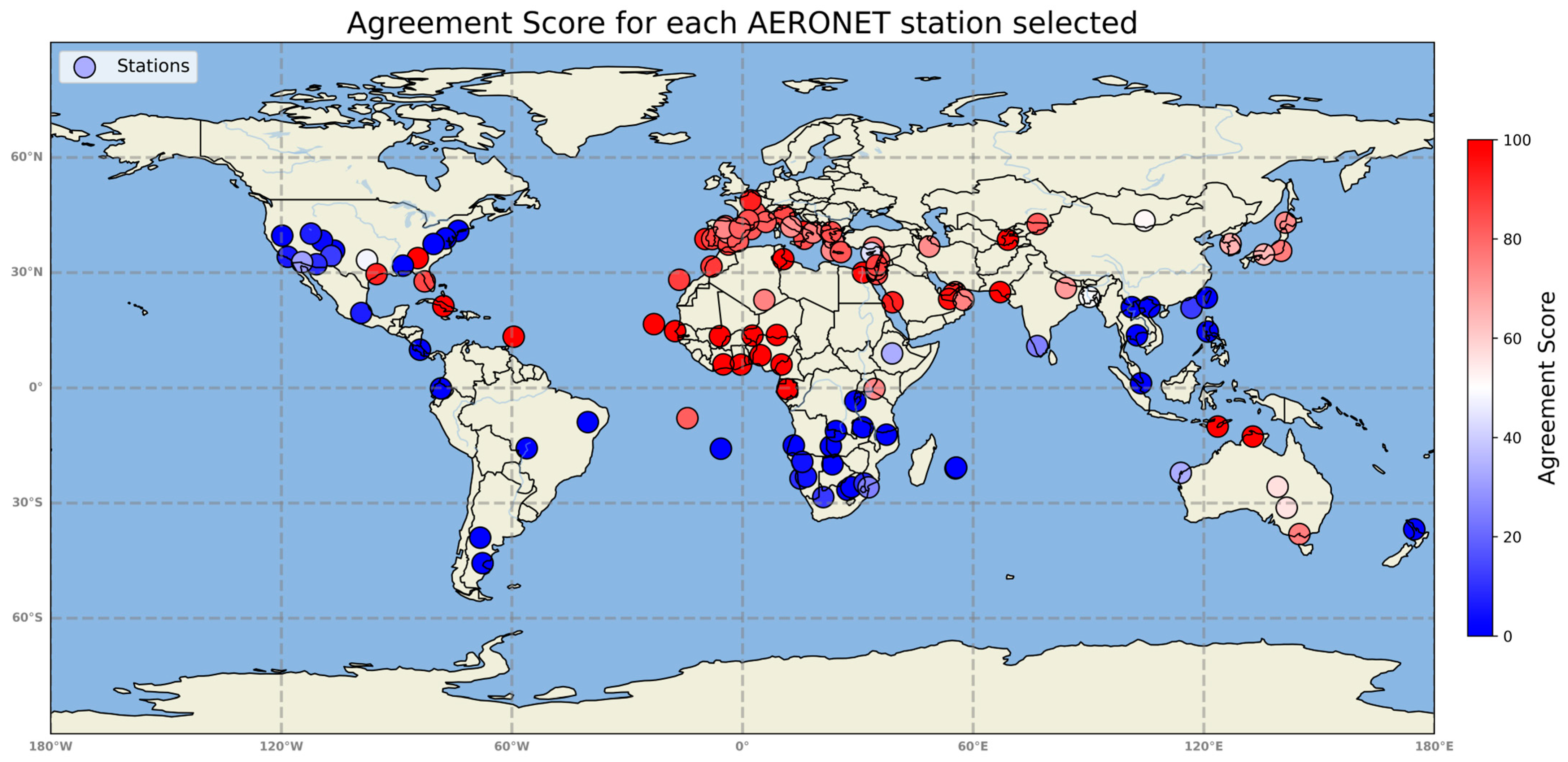
Disclaimer/Publisher’s Note: The statements, opinions and data contained in all publications are solely those of the individual author(s) and contributor(s) and not of MDPI and/or the editor(s). MDPI and/or the editor(s) disclaim responsibility for any injury to people or property resulting from any ideas, methods, instructions or products referred to in the content. |
© 2025 by the authors. Licensee MDPI, Basel, Switzerland. This article is an open access article distributed under the terms and conditions of the Creative Commons Attribution (CC BY) license (https://creativecommons.org/licenses/by/4.0/).
Share and Cite
Biskas, C.; Michailidis, K.; Koukouli, M.-E.; Balis, D. Evaluation of the IASI/Metop Dust Flag Product Using AERONET Data. Atmosphere 2025, 16, 1239. https://doi.org/10.3390/atmos16111239
Biskas C, Michailidis K, Koukouli M-E, Balis D. Evaluation of the IASI/Metop Dust Flag Product Using AERONET Data. Atmosphere. 2025; 16(11):1239. https://doi.org/10.3390/atmos16111239
Chicago/Turabian StyleBiskas, Christodoulos, Konstantinos Michailidis, Maria-Elissavet Koukouli, and Dimitrios Balis. 2025. "Evaluation of the IASI/Metop Dust Flag Product Using AERONET Data" Atmosphere 16, no. 11: 1239. https://doi.org/10.3390/atmos16111239
APA StyleBiskas, C., Michailidis, K., Koukouli, M.-E., & Balis, D. (2025). Evaluation of the IASI/Metop Dust Flag Product Using AERONET Data. Atmosphere, 16(11), 1239. https://doi.org/10.3390/atmos16111239






